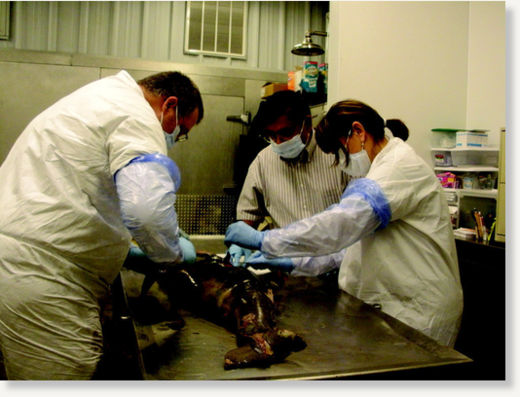
Despite what she called an "unusual mortality event" killing dolphins in the Gulf of Mexico, the top federal scientist investigating the deaths, revealed Wednesday that the government has yet to send any tissue samples for laboratory testing to determine a cause. The National Oceanic and Atmospheric Administration's Blair Mase blamed the delay on complications related to oil spill litigation.
A letter sent by NOAA to groups authorized to collect tissue samples from dead dolphins described the work as "a criminal investigation," according to Mase.
Nine more dolphin carcasses were recovered in Alabama and Mississippi between Saturday and Wednesday, bringing the total for the two states to 62 since Jan. 1, according to a list compiled Wednesday by the Institute for Marine Mammal Studies.
That list, which had been maintained online by the institute, has since been removed. The institute had been the only source for the specific locations and dates when dead dolphins were found. Federal officials provide only a state-by-state count.
The federal tally is now 114 dead dolphins found throughout the Gulf states. Fifty of them are listed as neonatal, meaning they were either stillborn or aborted by their mothers.
Federal statistics from 2002 to 2007 suggest about 14 dead dolphins would normally wash ashore between January and March along the entire Gulf Coast, with most of those in March, the beginning of the dolphin calving season.
The dolphins are considered potential evidence in the Natural Resources Damage Assessment, or NRDA, lawsuit federal officials will file against BP PLC, majority owner of the well that spawned the Gulf spill.
"The analytical facilities do not have the samples yet. We haven't sent them out. Once we identify the proper analytic labs, we'll send the samples out," said Mase.
She said that it would be months before any laboratory results would be available, and possibly longer before conclusions could be drawn.
"We have to be very methodical, particularly in regards to what facilities we use, the chain of custody," Mase said. "So I would say, yes, (the NRDA process) does play a role in this, in the delay."
No cause ruled out
While popular sentiment along the Gulf Coast leans heavily toward blaming BP's oil spill for the dolphin deaths, Mase said that NOAA isn't ruling anything out.
Among the possible causes under consideration:
- dinoflagellate blooms, such as red tide.
- snowmelt flowing into the Gulf from winter storms.
- morbillivirus, a dolphin virus related to measles and canine distemper.
- dietary disruptions tied to the oil spill.
- other spill related effects.
Ruth Carmichael, who studies marine mammals at the Dauphin Island Sea Lab, expressed frustration with NOAA and the National Marine Fisheries Service.
"It is surprising that it has been almost a full year since the spill and they still haven't selected labs for this kind of work," Carmichael said.



Stupid. We know the cause. The Gulf is a toxic place and will be for a long time.